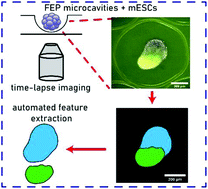Thin fluorinated polymer film microcavity arrays for 3D cell culture and label-free automated feature extraction†
Abstract
There is an increasing need for automated label-free morphometric analysis using brightfield microscopy images of 3D cell culture systems. This requires automated feature detection which can be achieved by improving the image contrast, e.g. by reducing the refractive index mismatch in the light path. Here, a novel microcavity platform fabricated using microthermoforming of thin fluorinated ethylene–propylene (FEP) films which match the refractive index of cell culture medium and provide a homogenous background signal intensity is described. FEP is chemically inert, mechanically stable and has been used as a substrate for light sheet microscopy. The microcavities promote formation of mouse embryonic stem cell (mESC) aggregates, which show axial elongation and germ layer specification similar to embryonic development. A label-free feature extraction pipeline based on a machine-learning plugin for FIJI is used to extract morphometric features from time-lapse imaging in a highly robust and reproducible manner. Lastly, the pipeline is utilized for testing the effect of the drug Latrunculin A on the mESC aggregates, highlighting the platform's potential for high-content screening (HCS) in drug discovery. This new microengineered tool is an important step towards label-free imaging of free-floating stem cell aggregates and paves the way for high-content drug testing and translational studies.



 Please wait while we load your content...
Please wait while we load your content...